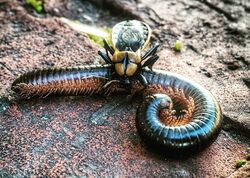Biology:Ectrichodiinae
From HandWiki
Short description: Subfamily of true bugs
| Ectrichodiinae | |
|---|---|

| |
| An unidentified ectrichodine preying on a millipede | |
| Scientific classification | |
| Domain: | Eukaryota |
| Kingdom: | Animalia |
| Phylum: | Arthropoda |
| Class: | Insecta |
| Order: | Hemiptera |
| Suborder: | Heteroptera |
| Family: | Reduviidae |
| Subfamily: | Ectrichodiinae Amyot and Serville, 1843 |
The Ectrichodiinae are a subfamily of assassin bugs (Reduviidae) known for specializing on millipedes as prey.[1] The group comprises more than 600 species in about 115 genera,[2] making it a fairly large subfamily. The bugs are also known for their aposematic coloration, often brightly colored metallic blue, red, or yellow.
Species of this subfamily hide under leaf litter and sometimes boulders and hunt at night.[3]
Females have wing reduction and or/ extreme sexual dimorphism.[4]
Genera
- Austrokatanga Weirauch, 2009
- Borgmeierina Wygodzinsky, 1949
- Brontostoma Kirkaldy, 1904
- Caecina Stål, 1863
- Choucoris Cai, 2000
- Daraxa Stål, 1859
- Echinocoris Livingstone & Ravichandran, 1992
- Ectrichodia
- Ectrychotes
- Glymmatophora Stål, 1855
- Guionius
- Haematorrhophus
- Hemihaematorrhophus Murugan & Livingstone, 1995
- Labidocoris
- Pseudozirta Berenger & Gil-Santana, 2005
- Rhiginia Stål, 1859
- Scadra
- Stegius
- Synectrychotes
- Vilius
- Zirta Stål, 1859
References
- ↑ Heteropteran Systematics Lab @ UCR. "Unlikely relationships: Ectrichodiinae + Tribelocephalinae". http://www.heteroptera.ucr.edu/index.php?option=com_content&task=view&id=43&Itemid=63. Retrieved Jan 14, 2010.
- ↑ (Maldonado 1990),
- ↑ "Austrokatanga, gen. nov., new genus of Ectrichodiinae (Hemiptera: Heteroptera: Reduviidae) from Australia". Zootaxa 2094: 1–15 (2009). http://www.mapress.com/zootaxa/2009/f/z02094p015f.pdf.
- ↑ FORTHMAN, MICHAEL; WEIRAUCH, CHRISTIANE (2017-06-06). "Millipede assassins and allies (Heteroptera: Reduviidae: Ectrichodiinae, Tribelocephalinae): total evidence phylogeny, revised classification and evolution of sexual dimorphism". Systematic Entomology 42 (3): 575–595. doi:10.1111/syen.12232. ISSN 0307-6970.
Wikidata ☰ Q5334317 entry
 |

